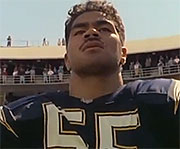
TUESDAY, Jan. 22 (HealthDay News) — Until now, scientists could only identify a sign of brain damage — called tau protein tangles — during an autopsy. Considered a hallmark of Alzheimer’s disease, tau tangles also occur in a devastating brain condition caused by head trauma.
In a new study, researchers describe how they pinpointed signs of tau in five former National Football League players who are still alive. The issue of sports-related concussions and brain injuries — particularly among football players — has generated headlines recently, especially after star NFL linebacker Junior Seau died by suicide last year.
The hope is that early identification of signs of brain injury in athletes would enable doctors to alert players to the possibility of devastating long-term damage before it occurs.
For the new study, researchers gave the ex-players a radioactive chemical that binds to tau tangles in the brain so that affected areas light up on PET scan imaging tests.
“All the players had high signals in the brain in areas that other studies of autopsy in chronic traumatic encephalopathy patients have found high concentrations of tau,” said lead study author Dr. Gary Small, a professor of psychiatry and biobehavioral sciences at the University of California, Los Angeles.
Seau, who died by suicide last May at age 43, was found to have tau tangles in his brain during an autopsy, according to a Jan. 10 statement from the U.S. National Institutes of Health. The NIH concluded that he had suffered from chronic traumatic encephalopathy, a condition associated with multiple hits to the head and concussions.
The new UCLA study appears online Jan. 22 in the American Journal of Geriatric Psychiatry. Because of the study’s small size and design, it’s far from definitive and will have to be verified by more extensive research, Small noted.
The study participants, who included a linebacker, a quarterback, a guard, a center and a defensive lineman, were “what we call a convenience sample,” Small said. “We reached out to contact the [NFL] players’ association and other groups to find individuals who had cognitive [thinking] or mood symptoms.” All the players had suffered at least one concussion and had symptoms including depression, dementia and problems with memory and thinking ability.
One of the five players, who is in his 60s, just has signs of normal aging, Small said.
All the study participants received an intravenous injection of a radioactive chemical called FDDNP, which binds to tau protein in the brain. UCLA holds a patent on FDDNP.
“It’s a very small chemical that has a radioactive label attached to it and the PET scanner acts as Geiger counter and measures its radioactivity,” Small explained.
Dr. Howard Derman, medical director of the Methodist Concussion Center in Houston, which collaborates with the Nantz National Alzheimer Center on research into possible links between concussion, head injuries and dementia, discussed the implications of the new research.
At present, he said, “In terms of what we can do for patients, it’s not much. We can use more sophisticated imaging. We use PET scanning all the time, but PET scanning with an isotope that binds to brain plaque and tangles — it’s the isotope that adds a new dimension.”
Derman, who was not involved with the UCLA study, said that if proven to work by further research, the new method “might be useful to give athletes guidance. If you took an athlete and followed him sequentially after each concussion and then [the brain area] lights up, you might want to say it’s time” to think about retiring.
“I’m more than cautiously optimistic — but it’s [only] five players,” Derman said.
Study author Small said that “there’s a lot of overlap between Alzheimer’s disease, brain aging and traumatic brain injury. We know NFL players have a fourfold greater likelihood of dying from Alzheimer’s disease than people in the general population.”
He said the ability to detect tau in living players “offers us the hope that we can identify individuals before there’s a lot of symptoms and try to protect the healthy brain rather than try to repair damage once it’s done.”
However, with little effective treatment available to treat Alzheimer’s, the value of having that early knowledge might be unclear.
“While we’re waiting for science to catch up, we’ve done a lot of research in the area of healthy lifestyles to protect the brain — physical and aerobic conditioning, proper diet, stress management,” Small said. “For people with memory problems, learning ways to compensate for their cognitive decline is very important.”
More information
Visit the Boston University Center for the Study of Traumatic Encephalopathy to learn more about chronic traumatic encephalopathy.

